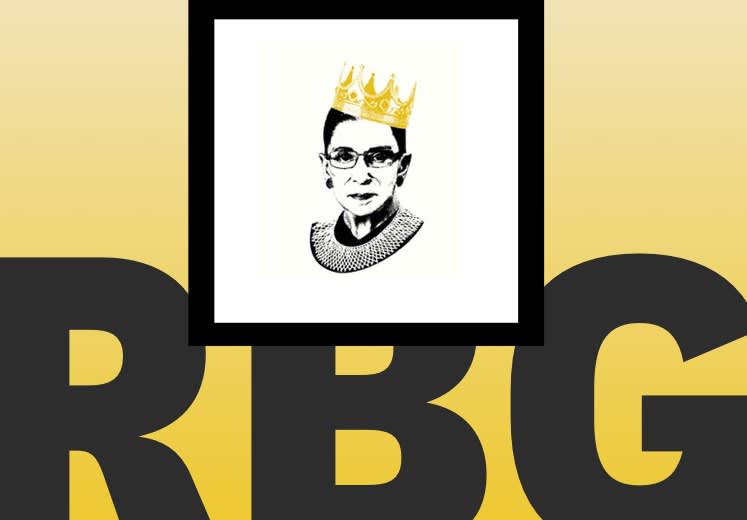Two years ago, I asked U.S. Supreme Court Justice Ruth Bader Ginsburg in an interview how she wanted to be remembered — when the time came to remember her in the past tense. “Someone who used whatever talent she had to do her work to the very best of her ability,” she replied. “And to help repair tears in her society, to make things a little better through the use of whatever ability she has.”
The words had a familiar ring. Ginsburg’s reference to patching a ripped-up planet echoes the Jewish concept of tikkun olam, literally “fixing the world” in Hebrew. She herself has defined it as “the obligation to improve/fix/better the world carefully and steadily, to do one’s part to make our communities, nation, and universe more humane, fairer, more just.” To listen to My Own Words, an anthology of the justice’s life’s work, with richly reported introductions (narrated by both Ginsburg and actress Linda Lavin) from her official biographers, Mary Hartnett and Wendy W. Williams, is to trace Ginsburg’s devotion to tikkun olam all the way back to her early teens.
“We are part of a world whose unity has been almost completely shattered,” the eighth-grader wrote in the June 21, 1946, edition of the Bulletin of the East Midwood Jewish Center. “No one can feel free from danger and destruction until the many torn threads of civilization are bound together again.”
Even as a child, she keenly observed the horrors of the world, and yet she somehow remained optimistic that, with careful action, it all could be knit back together.
Her complete essay appears in the audiobook as one of several previously unpublished early pieces in which the future associate justice is unmistakably recognizable. Even as a child, she keenly observed the horrors of the world, and yet she somehow remained optimistic that, with careful action, it all could be knit back together.
It is tempting to focus on the irresistibly specific and fresh nuggets in the introductions to My Own Words: glimpses at her life before she donned the robe, at the child and young woman who would become a feminist icon. How early efforts to force a left-handed Ruth to write with her right hand resulted in her first and last D in a class (the well-behaved but iron-willed Bader refused to ever write with her right hand again). How Kiki, as her younger sister nicknamed her, learned to dance playing records she and her cousin bought “in a tiny store in the Times Square subway stop.” How she was wretched at sewing and cooking in home economics class and envied the boys their shop class. How, as her mother got her hair done, the future feminist litigator searched the library for independent-minded heroines and found them in Jo March and Nancy Drew.
Some inside glimpses are more recent, like the tick-tock of Ginsburg’s nomination to the Supreme Court. “Bill Clinton, whatever his problems were, talks comfortably to women,” Ginsburg drolly recalls of her interview with the president before her appointment. It is worth understanding Ginsburg as a person as well as a jurist and a feminist trailblazer.
But it’s not enough to stop there. There is no denying that our country’s wounds seem far from repaired but, rather, freshly opened. Ginsburg is witnessing a fierce backlash to the values she spent her life fighting for, and the brunt is likely to fall on the backs of the most vulnerable.
As an activist, she hoped to lay the groundwork for more lasting change by being strategic and incremental.
This means that My Own Words takes on a new significance. As it happens, Ginsburg knows from backlash. Until Jimmy Carter appointed her to the federal bench in 1980, she agitated for gender equality through the courts, legislation, and public education as the co-founder of the American Civil Liberties Union’s Women’s Rights Project. Ginsburg managed to persuade the Supreme Court to read women’s equality into the Constitution after centuries of legal discrimination. Up against a long history of sexism, she lost only one case. But there were setbacks, too. A cause she joined and passionately fought for, the Equal Rights Amendment, seemed to have momentum until it was felled by an avalanche of opposition led by anti-feminist Phyllis Schlafly. Just as she began her career as a judge, Ginsburg watched as the conservative revolution took a hacksaw to so much of what she’d fought for.

My Own Words doesn’t say much about those years. Ginsburg has long played a long game, at times to the frustration of her allies. As an activist, she hoped to lay the groundwork for more lasting change by being strategic and incremental. Hartnett and Williams neatly describe this as “her concern that shortcuts in the name of efficiency often reduce effectiveness in the long run.”
As a lawyer, she practiced persuasion over purity. In a 2008 speech looking back at her work in the 1970s, Ginsburg talks about the virtues of “knowing the audience — largely men of a certain age. Speaking to that audience as though addressing one’s ‘home crowd’ could be counterproductive.” She and her colleagues, she writes, “saw ourselves as teachers appearing before audiences that, on the realities underlying our cases, had not advanced much beyond the third grade. Her patient teaching bore fruit in 1996, when, as a Supreme Court justice, she wrote the 8-1 majority opinion in United States v. Virginia, ending gender discrimination at the Virginia Military Institute and all but closing the circle on her legal work in the 1970s.

Intro and Reading of VMI Decision
By: SCJ Ruth Bader Ginsburg
From My Own Words, narrated by actress Linda Lavin.
None of this has required stinting on her values. Ginsburg has remained an unapologetic advocate for civil rights, fairness, and equality. She has never stopped saying the world would be better if people shut out of power were allowed to realize their true potential. That includes demanding that we all question our assumptions about leadership. Ginsburg likes to say that there will be enough women on the court “when there are nine,” and adding that no one has “ever raised a question” with centuries of male leadership. My co-author, Shana Knizhnik, nicknamed her “the Notorious RBG” because this famously reserved justice became a voice of dissent in opinions that encroached on racial justice, voting rights, employment discrimination, and reproductive freedom.
Ginsburg has survived plenty of trials: in early life, the deaths of her sister and her mother. As a young law student and mother, her husband’s cancer. As a Supreme Court justice, her own bouts with cancer and the death of her husband. In times of adversity, she writes that she hearkens back to her father-in-law’s advice at a trying time, that she spend “no time fretting, and found a way to do what I thought important to get done.”
I asked Shana what lessons she was drawing from Ginsburg’s life and work in a changed world. “There is power in engaging with your adversaries, both as an ideological strategy and on a purely human level,” she replied. “Especially in today’s political climate, it is remarkably easy to dismiss foes as irredeemable, but RBG teaches us that reaching out in the name of justice to those who may in fact be convinced is never a wasted effort. As the apparent influence of logic and reason continues to wane in our new, fact-free world, we must never stop appealing to basic human values to show our interconnectedness as individuals, and as a collective whole.”
Indeed, in the voting-rights dissent that made her the Notorious RBG, Ginsburg had a few words to append to the famous Martin Luther King, Jr. quote. “The arc of the moral universe is long, but it bends toward justice,” she said, then added, in a reminder of her own promise to fight for the mending of the world, “if there is a steadfast commitment to see the task through to completion.”





